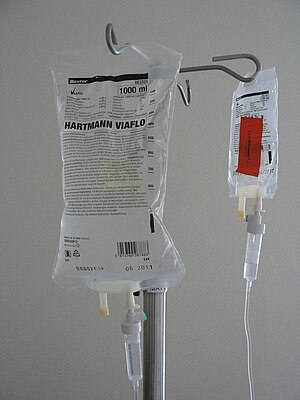Diabetic ketosis
| Diabetic ketoacidosis | |
|---|---|
 |
|
| Dehydration may be severe in diabetic ketoacidosis, and intravenous fluids are usually needed as part of its treatment | |
| Classification and external resources | |
| Specialty | Endocrinology |
| ICD-10 | E10.1, E12.1, E13.1, E14.1 |
| ICD-9-CM | 250.1 |
| DiseasesDB | 3709 |
| MedlinePlus | 000320 |
| eMedicine | med/548 |
| Patient UK | Diabetic ketoacidosis |
| MeSH | D016883 |
Diabetic ketoacidosis (DKA) is a potentially life-threatening complication of diabetes mellitus. Signs and symptoms may include vomiting, abdominal pain, deep gasping breathing, increased urination, weakness, confusion, and occasionally loss of consciousness. A person's breath may develop a specific smell. Onset of symptoms is usually rapid. In some cases people may not realize they previously had diabetes.
DKA happens most often in those with type 1 diabetes, but can also occur in those with other types of diabetes under certain circumstances. Triggers may include infection, not taking insulin correctly, stroke, and certain medications such as steroids. DKA results from a shortage of insulin; in response the body switches to burning fatty acids which produces acidic ketone bodies. DKA is typically diagnosed when testing finds high blood sugar, low blood pH, and ketoacids in either the blood or urine.
The primary treatment of DKA is with intravenous fluids and insulin. Depending on the severity, insulin may be given intravenously or by injection under the skin. Usually potassium is also needed to prevent the development of low blood potassium. Throughout treatment blood sugar and potassium levels should be regularly checked.Antibiotics may be required in those with an underlying infection. In those with severely low blood pH, sodium bicarbonate may be given; however, its use is of unclear benefit and typically not recommended.
...
Wikipedia
